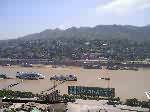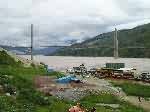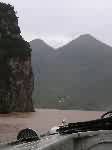- Getting around Lijiang. Dont stay in the Old Towns more than 2 days, there is nothing to do. KRISS Oct 9, 2013 05:46
- 2013 Beijing Temple Fair BENNYLAU Feb 26, 2013 03:29
- Malaysian traveling from KUL - LAX vis Shanghai PVG ZATI_DY Jan 3, 2013 20:15
<A> CRUISING THE YANGTZE POST SARS JULY 2003
- Views: 3047
- |Vote: 0 0
- |Add to Favorites
- |Recommend to Friends
The SARS crisis had waned and I was finally free to leave Chongqing for my first summer holiday in China. I had chosen to begin with a cruise down the famous Three Gorges to Yichang. Much to my disappointment the new dam came on line in June during the SARS crisis and the water level had already risen considerably, spreading the banks and flooding many cities, villages and historic sites. The mountains that the Chang Jiang (Yangtze) has carved a path through are over 1000mts high, and despite the flooding, they are still an impressive sight.
My boat left around 8.00pm in the evening and we spent three nights and two days on the river. My friends carefully arranged for me to share a cabin with three other females, however that did not last too long. I shared a four-birth cabin with a variety of other passengers during the trip, a family of three sharing one bunk, a mother who had just lost her soldier son in an accident and didn’t know it yet although I’m sure she sensed something was amiss, and another who snored both day and night making it impossible for me to get a good night’s sleep. She also had a number friends traveling in a cheaper class who popped in to use our cabin’s private facilities.
Our first port of call early the next morning was Fengdu or ‘Ghost City’ so named for the myths surrounding the place. A new city has been built on the opposite bank and now what remains standing amongst the rubble of the old city is ironically a ‘ghost city’. We scrambled ashore up the bank of broken brick and tiles and remnants of household goods to take a chair lift to the top of Ming Shan to visit the Temple area, which affords a good view of the river on a clear day. Unfortunately rarely seen in this neck of the woods. We then rushed around the rest of the old village, which has an area depicting ‘Hell’ and hurried back our boat, which does not wait for stragglers.
What little remains of the original city will eventually be demolished as the water level rises another 40metres in the next few years. It was quite daunting to see the size and scale of the relocation programme of an entire city the size of Fengdu, which is just one of many cities, villages and bridges that have been demolished and rebuilt further up the hillsides to accommodate the flooding.
Our next stop was just after lunch at a place I can’t pronounce, Shibaozhai. Interesting for the wooden pagoda like structure built against the sheer rock face to house steps from the lower to the upper part of the temple. Again what is left of this area’s riverbank below the final water level has been reduced to rubble with venders selling food and souvenirs along a narrow muddy, rubble-strewn path up the riverbank. At times it is so congested with vendors, sedan chairs and tourist scrambling in both directions, it’s almost impossible to negotiate the path and enjoy this stopover. It is inevitable that more than one cruise ship will dock at the same time, all having tight schedules, passengers run the risk of their boat leaving without them.
The first of the three gorges, the Qutang is not the most spectacular and this we passed through late on the first afternoon. Our ferry stopped regularly to pick up and put down passengers and tied up at night for a several hours. Early the second morning we arrived at Wushan at the mouth of the Danang River, home of the Lesser Three Gorges and after breakfast we transferred to smaller vessels for the 3 hour trip through these gorges. Unfortunately they have lost some of their charm as the water now covers the old plank road and many of the hanging coffins and is going to rise even further drowning more of the lower slopes and the pretty little bridge that spans the river mouth. In the past the water level was often too low for the passage of boats during some seasons. All the same they are more spectacular than the major gorges, still quite narrow and shrouded in mist and so very cool even at midday. We spotted a group of small monkeys and some goats on the banks.
One of the most noticeable things was all the debris in the rivers, huge rafts of it and especially in the lesser gorges where the water generally flows green and clean in comparison to the mighty Chang Jiang, which is consistently brown. Men on sampans were desperately trying to clean up, piling the flotsam onto their boats or the banks but it will eventually wash back into the rivers next time it rains or when the water level rises again. White Styrofoam and shoes seemed the biggest offenders, left in the rubble of demolished buildings now submerged.
Amongst the passengers on our boat was a large contingent of Chinese English teachers on an end of year school sponsored holiday to Chongqing who were cruising home to Yichang. They ventured to chat with me and explain a little of the ship’s commentary that was only available in Mandarin. They had a lot of children traveling with them and together we posed for many photos with the mighty river and mountains behind us. This has been a common occurrence wherever I have been.
Later that afternoon we passed through the second gorge on the Yangtze, the Wu, by far the largest and some of the passengers helped to explain the names of some of the impressive peaks (just a little smaller now) as we passed by. I was now able to view them from the top deck of the ferry in the hot noonday sun (usually an additional fee for the privilege of the top deck). By now I was just happy to see so much clear blue sky!
Just before dark we arrived at the new dam and waited a short while for all the boats to arrive for the trip through the locks. I think there where six other ferries and one freighter squeezed in with us. I headed for my cabin about 9.00pm to see if I could steal some quiet time but the loud speaker was playing music so I just rested until we passed through the locks and came at last to the most exciting of the gorges. The Xiling is the smallest and the most treacherous of them all. Because it is mostly below the dam the water still swirls and rushes about and our boat was rolling and traveling much faster. The moon was full and bright so I just lay on my bunk and watched the peaks ‘roll’ by one after another in the moonlight. It was a lovely way to finish an otherwise very tiring cruise.
We docked in Yichang at 3.00am where I had reserved a hotel room and got just three hours sleep before taking a bus to Wuhan where I spent all afternoon catching up on sleep since it was too hot to do anything else. Next time I cruise the Chiang Jiang I think I will do it in more style.
NB Cruising upstream usually takes a little longer for the obvious reason that the boat is traveling against the flow of a tremendous volume of water. The upstream cruise generally stops at different sights than that of the downstream cruise so check first to be sure that your boat's itinerary includes what you want to see.
Princess Jeannie in port, Chongqing







 Copyright © 1998-2025 All rights reserved.
Copyright © 1998-2025 All rights reserved.